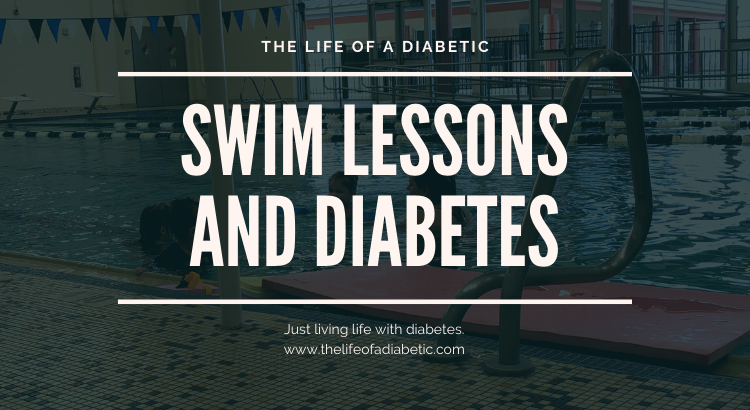We were late to the swim lesson game. We didn’t start swim lessons until after she was 4 years old. She knew how to do some basic stuff in a pool just from our own lessons of teaching her in the pool.
We decided that we wanted to do real swim lessons at our local community center. Of course we had to take extra steps and precautions with her type 1 diabetes.
Meeting with the Teacher Ahead of Time
When we signed her up, we explained to the community center that she had Type 1 Diabetes and wanted to speak directly to the teacher so we could talk to her about symptoms of lows and diabetes in general.
It’s important for us to meet with any teacher beforehand to discuss diabetes and to go over signs and symptoms of a low blood sugar. We also wanted to make sure that it was going to be OK for us to be in the pool area for the swim lessons.
We don’t plan on being helicopter parents forever, but diabetes was still new to us and so were swim lessons.
We don't plan on being helicopter parents forever, but diabetes was still new to us and so were swim lessons. Click To TweetThe teacher was very responsive to learning and caring of making sure to keep a closer eye on our daughter.
Dexcom for the Win
Luckily, she was using a Dexcom during the swim lessons. We were able to track her blood sugars from the bleachers and know which way her blood sugars were trending. This was huge for us.
I’ve heard so many stories (and myself included) about swimming just tanking a blood sugar. My blood sugar drops quick soon after being done swimming. It doesn’t hit me right away, but everyone is different.
We would do a finger BG check beforehand just to ensure that the Dexcom was accurate.
Monitoring Dexcom
The swim lessons were in an indoor swimming pool, so there were bleachers next to the pool. Perfect for parents who wanted to be close by and watch their kids closely during swim lessons.
Some parents just dropped their kids off and left and some stayed but weren’t really paying attention and then there was us. The parents who were watching every movement.
I wasn’t watching to make sure she was swimming properly and following directions, I was purely watching to look out for symptoms of a low or something diabetes related.
We were also monitoring her Dexcom closely. There were times in the bathtub and pool that her Dexcom would lose signal, so we were monitoring it to look for trends in case it did lose signal.
Lower Blood Sugars Later
As I mentioned above, when I swim, my blood sugar doesn’t tank immediately, but it does go down pretty quickly after I am done. I wasn’t sure how swimming would effect my daughter, so we were thankful to have the Dexcom.
Her blood sugars stayed pretty stable during swim lessons, so we didn’t have to worry too much about it. The swim lessons were at 6 pm, so we ate dinner beforehand and then went to swim.
I think that helped because instead of her spiking after dinner, we went to swim lessons, so it equalled out.
We did start to see her blood sugars slowly go down after we came back and when we were getting ready for bed and also after she went to sleep.
To not have to worry about lows in the middle of the night, we typically ended up giving her a small snack before bed.
We were not comfortable enough with temp basals on the Omnipod at that time, so we didn’t use them. Now, we are much more comfortable with the Omnipod to do it.
It was a lot of stress, but the more she swam, the more comfortable we were with it.
How do you handle swimming and blood sugars? Do you drop quickly during or after? Or both? What strategies do you use?
Please comment on this post or head on over to Facebook or Instagram to continue the conversation.
